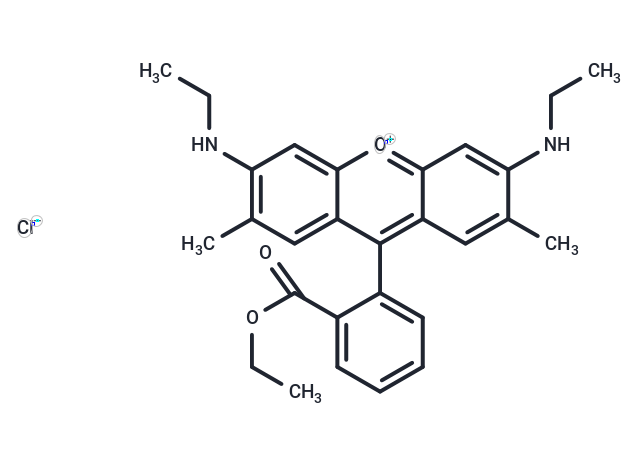Shopping Cart
Remove All Your shopping cart is currently empty
Your shopping cart is currently empty
Rhodamine 6G (Basic Red 1) is a rhodamine analog useful in Pgp efflux assays. It can be widely used in characterizing the kinetics of MRP1- mediated efflux as a laser dye and potential mitochondrial probe.

| Pack Size | Price | USA Warehouse | Global Warehouse | Quantity |
|---|---|---|---|---|
| 200 mg | $36 | In Stock | In Stock | |
| 500 mg | $55 | In Stock | In Stock | |
| 1 g | $78 | - | In Stock | |
| 5 g | $118 | - | In Stock | |
| 10 g | $157 | - | In Stock | |
| 1 mL x 10 mM (in DMSO) | $29 | In Stock | In Stock |
| Description | Rhodamine 6G (Basic Red 1) is a rhodamine analog useful in Pgp efflux assays. It can be widely used in characterizing the kinetics of MRP1- mediated efflux as a laser dye and potential mitochondrial probe. |
| In vitro | Rhodamine 6G, also known as Rhodamine 590, is widely used as a lasing medium and as a fluorescence tracer. Rhodamine 6G is a fluorescent dye capable of penetrating a living cell. Upon entering the cell, Rhodamine 6G binds to the inner membranes of mitochondria. Based on these observations, it has been proposed that Rhodamine dyes may be used for producing fluorescent images of mitochondria with low background noise and high resolution. Extremely low concentrations of Rhodamine 6G appear to selectively destroy malignant cells in culture, sparing the normal cell populations[2]. |
| In vivo | Compared to their untreated counterparts, Melanoma-transplanted mice receiving Rhodamine 6G demonstrate prolonged survival, inhibited tumor growth, improved clinical parameters and metastases count. It is possible to monitor changes in the interactions between leukocytes and the endothelium by determining the numbers of rolling and adhering leukocytes as well as the total flux of these cells[3]. The Rhodamine-6G enters the circulatory system and labels leukocytes. Twice-a-week 10-6M Rhodamine 6G regimen yield the most prominent results[2]. |
| Cell Research | 1. Solution preparation 1. Mother solution preparation: Dissolve Rhodamine 6G in an appropriate solvent (such as DMSO or PBS) to obtain the required mother solution, 1-100mM. 2. Working solution preparation: Dilute the mother solution into the required working solution using PBS/DMEM/H2O, usually with a concentration range of 1-20μM. 2. For drug efflux studies 1. Cell treatment: Add the dissolved Rhodamine 6G to the cultured cells and incubate with the drug to study the drug efflux process. 3. Efflux kinetics determination: Monitor the fluorescence changes of Rhodamine 6G by fluorescence microscopy or flow cytometry to evaluate the kinetics of drug efflux. 3. As a mitochondrial probe: 1. Dye working solution concentration: Usually the working solution concentration ranges from 1-5 μM. 2. Cell incubation: Add the dissolved dye to the cell culture medium and incubate for a certain period of time (usually 30 minutes to 1 hour) to allow it to enter the cells and accumulate in the mitochondria. 3. Fluorescence microscopy observation: Use a fluorescence microscope to detect the fluorescence signal of mitochondria and observe the distribution and function of mitochondria. 3. As laser dye: 1. Dye working solution concentration: Usually the working solution concentration is 10-100 μM. 2. Laser dye application: Apply the dye to the laser system, or use it for fluorescence microscopy or flow cytometric analysis. 3. Fluorescence signal detection: Detection is performed by fluorescence microscope, flow cytometer or other laser analysis equipment. |
| Synonyms | Basic Red 1 |
| Molecular Weight | 479.01 |
| Formula | C28H31ClN2O3 |
| Cas No. | 989-38-8 |
| Smiles | [Cl-].CCNc1cc2[o+]c3cc(NCC)c(C)cc3c(-c3ccccc3C(=O)OCC)c2cc1C |
| Relative Density. | 1.15g/cm3 |
| Storage | keep away from direct sunlight | Powder: -20°C for 3 years | In solvent: -80°C for 1 year | Shipping with blue ice/Shipping at ambient temperature. | ||||||||||||||||||||||||||||||||||||||||
| Solubility Information | H2O: 83.3 mg/mL (173.9 mM), Sonication is recommended. DMSO: 15.625 mg/mL (32.62 mM), Sonication is recommended. | ||||||||||||||||||||||||||||||||||||||||
Solution Preparation Table | |||||||||||||||||||||||||||||||||||||||||
DMSO/H2O
H2O
| |||||||||||||||||||||||||||||||||||||||||
| Size | Quantity | Unit Price | Amount | Operation |
|---|

Copyright © 2015-2026 TargetMol Chemicals Inc. All Rights Reserved.